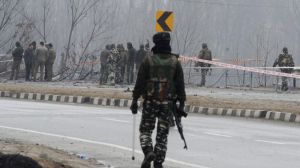Symbol of Life
‘‘Till now, this jaali was just another protected monument, one of those structures that are part of our cultural heritage. A plac...

|
Anuradha Vakil
designer at Sidi Sayeed Mosque, Ahmedabad |
THE gardener waters the lawn, his movements disturbing a few pigeons roosting in the masjid premises. They fly off, their fluttering wings seeming to shatter the peace at Sidi Sayeed Mosque, located in the heart of Ahmedabad. All around us, the traffic continues to move ahead at breakneck speed. But in the garden of the mosque built by Sidi Sayeed, a slave of Ahmed Shah (after whom the city is named), there’s peace and quiet. In her green salwar kameez, designer Anuradha Vakil effortlessly blends in with the surroundings.
‘‘It’s a place which I drive by often. It’s not possible to be in Ahmedabad and close your eyes to the Sidi Sayeed Jaali. I love this city and I love this place,’’ Vakil says. ‘‘But, come to think of it,’’ she smiles, ‘‘this is the first time that I’ve entered the premises.’’ The famed Tree of Life jaali, with its intricate carving and balance, is quite like Vakil’s designs. Simple, subtle and stylish. But she’s not interested in talking about herself yet.
As we walk on, she opens up. ‘‘It’s been around seven years since I began designing, without any formal training whatsoever. Actually, I studied in the US and got an MBA. Ironically, today I look after the creative aspect of the work, and leave the business side to others.
‘‘I’ve often been labelled arty, and I must confess that I don’t quite know what that means. I myself would call my work timeless, elegant — after all, I’ve never worked according to market demands. I firmly work by the rule that the day I don’t enjoy creating then it’s going to show in my work,’’ Vakil says.
Sometime later, her mind goes back to the riots. ‘‘You know, the earthquake was fate. There was nothing one could do. But this bloodshed was something else. Ahmedabad has never been immune to riots. But there’s never been this kind of nastiness before. And to a person who loves this city as dearly as I do, it’s a body blow,’’ she says.
After a few moments of contemplative silence, she speaks up again. ‘‘But then Amdavadis are very resilient. They put the quake behind them and are making all efforts to forget the riots. Perhaps, peace will prevail,’’ she says. On that optimistic note, we part ways.
Photos





- 01
- 02
- 03
- 04
- 05


























